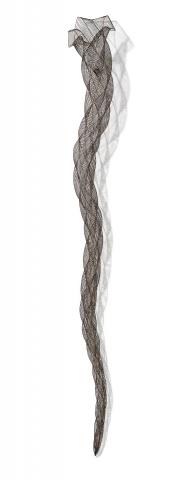STRIATION, 2004
BRONWYN OLIVER
copper
212.0 cm height
Christine Abrahams Gallery, Melbourne
Private collection, Sydney
Bronwyn Oliver, Christine Abrahams Gallery, Melbourne, 17 November – 11 December 2004
Twisting and turning in an effortless motion, Striation is an ethereal example of Bronwyn Oliver's flawlessly constructed forms that juxtapose fragility against strength and the familiar against the foreign. Derived from the word stria, the title of this sculpture refers to the parallel 'scratches or tiny grooves on the surface of a rock, resulting from the action of moving ice, as of a glacier'.1 Recreating this natural phenomenon, Oliver has taken these parallel markings and weaved them into an organic form, achieved through an equal partnership between the artist and the independent life of the sculpture. The viewer is drawn to the exposed skeleton of this otherworldly object, alluding to a primordial foreign creature or an overgrown botanical organism. We are not entirely sure what the object is, or what it looks like, but the sensuous curves and the enigmatic form exudes familiarity. Upon closer inspection, it becomes apparent that the evenly spaced copper strands are too perfect for the natural world and as Oliver herself has discussed, she was never interested in the observation of nature, despite the many parallels between her sculptures and various creatures and natural objects.2 Rather, her primary concern was in the structure of materials and the idea of a sculpture taking on its own life.
In Striation, Oliver has stripped the ideology and associations of the sculpture down to the bare bones, both in a physical and metaphorical sense, revealing a delicate husk and the life inside. Oliver's creations belong neither to past or present civilisations and are neither mythical nor factual. Timeless in their appearance, they are disconnected from a specific place, object or era and instead suggest a precious life force that connects deeply to the human soul.
Manipulating the copper through her meticulous craftsmanship, Oliver is regarded as one of Australia's most significant contemporary sculptors - 'the delicate friction between surface and depth breathes life into her objects: dense surfaces with translucent and vital interiors of air and light. Her objects are often sphere-like with hollow spaces or openings - openings which lead to somewhere else, devolving from where they started. In the exchange between these aspects, Oliver's sculpture suggests a passage from one place to another, a journey from a material dimension into an imaginative, other world.'3 As demonstrated in Striation, Oliver leaves behind a legacy of pure beauty, fragility, strength and life.
1. The Macquarie Dictionary, Macquarie University, New South Wales, 1981, p. 1678
2. Sturgeon, G., Contemporary Australian sculpture, Craftsman House, Sydney, 1991, p. 72
3. Bullock, N., in Bond, T., and Tunnicliffe, T. (eds), Contemporary: Art Gallery of New South Wales Contemporary Collection, Art Gallery of New South Wales, Sydney, 2006, p. 326
CASSI YOUNG
